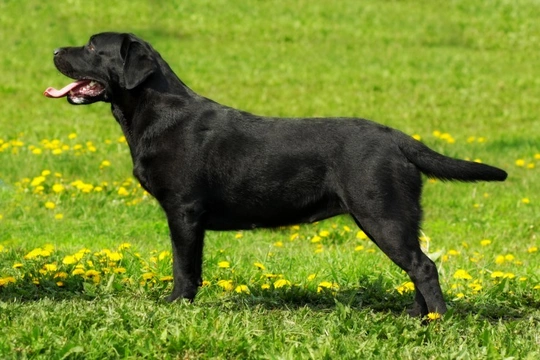
Skeletal Dwarfism (SD2) testing for the Labrador retriever
Skeletal dwarfism (also sometimes known as skeletal dysplasia) or SD2 for short is a hereditary health condition that affects some dogs of the Labrador retriever breed. The condition occurs due to a mutation of the COL11A2 gene, which is responsible for the form of skeletal dwarfism called SD2.
Whilst dwarfism is a desirable trait in some breeds of dog, which have been selectively bred for their distinctive long back and short legged appearance (like the Dachshund and the Basset hound) it is of course seen as a flaw in other breeds for whom it is not the breed norm, like the Labrador retriever.
In the Labrador retriever breed, SD2 dwarfism is a form of disproportionate dwarfism, which means that the balance between normal-sized body parts and abnormally small ones is not in proportion.
This usually presents as short legs with a normal length of body in the Labrador, and sometimes, the front legs are abnormally short to a greater extent to the hind legs. As well as the abnormal shortness of the limbs, the bones of the radius and ulna tend to be slightly bowed too.
Labradors are usually classed as suffering from skeletal dwarfism if they stand under 55cm tall at the shoulder (for males) or 50cm (for females) when fully grown, with disproportionate legs compared to the body. However, in bloodlines that tend to produce particularly tall Labradors, they may be slightly taller and still be diagnosed as suffering from the condition.
Because skeletal dwarfism in the Labrador retriever is a hereditary defect, The Kennel Club oversees a testing and monitoring scheme for the condition in the Labrador breed, to allow Labrador retriever breeders to find out their own dog’s status prior to breeding and make an informed decision about any potential match.
In this article, we will look at skeletal dwarfism in the Labrador retriever in more detail, including how the heredity of the condition works, and how to get your dog tested. Read on to learn more.
More about skeletal dwarfism in the Labrador retriever
Dwarfism of all forms in both people and dogs is caused by a genetic mutation, which can affect the body in various different ways as well as by means of causing an abnormally short stature and disproportionate limbs.
However, skeletal dwarfism in the Labrador retriever does not cause any other health problems or complications in the breed other than their short stature and sometimes, disproportionate limbs, and while affected dogs may look rather unusual, they should be able to enjoy a normal quality of life and average lifespan.
This type of dwarfism begins with puppies that are born looking normal, and the condition only begins to become apparent when the pups begin to grow and develop, as skeletal dwarfism inhibits the normal growth of the long bones (such as those in the legs) whilst the other bones continue to grow as normal. This usually becomes apparent in affected dogs from a young age, and will be well established by the time the dog reaches six months old.
What sort of dogs can be affected by the condition?
The SD2 variant of skeletal dwarfism has only been identified in dogs of the Labrador retriever breed, and while it is not widely spread across the breed as a whole, it is important that Labrador retrievers that are intended to be used for breeding are tested for their status of the condition in order to prevent it spreading to their offspring.
While it is obvious when an adult dog is affected by the condition and so, unlikely that they will be bred from, dogs can also be carriers for the condition and so, pass the gene mutation onto their young without ever suffering from the condition themselves.
Cross breed dogs with one Labrador retriever parent may inherit one of the two mutated genes that cause the condition, but unless they have Labrador ancestry on both sides of their bloodline and both sides are also carriers of the condition, they will not be affected themselves.
How does the heredity of the condition work?
Skeletal dwarfism is an autosomal recessive hereditary health condition, which means that the combination of genes inherited from both parent dogs is what dictates the status of their litter.
Dogs are referred to as either clear, carriers or affected, and carriers will not suffer from the condition themselves, but can still pass the gene mutation on to their offspring. The status of any potential litter can be determined by knowing the status of the two parent dogs:
- Two clear dogs will have a clear litter.
- Two affected dogs will have an affected litter.
- Two carriers will have a mixture of 50% carriers, 25% affected and 25% clear.
- A clear dog and an affected dog will have a litter of carriers.
- A clear dog and a carrier will have 50% clear and 50% carriers.
- A carrier and an affected dog will have 50% carriers and 50% affected.
How to get your dog tested for their status
In order to find out your dog’s status and so, make an informed decision about the viability of any breeding match, you simply need to ask your vet to take a DNA sample from your dog and send it off to one of The Kennel Club’s approved laboratories for testing.
They will then return the results of your dog’s status to you directly.



